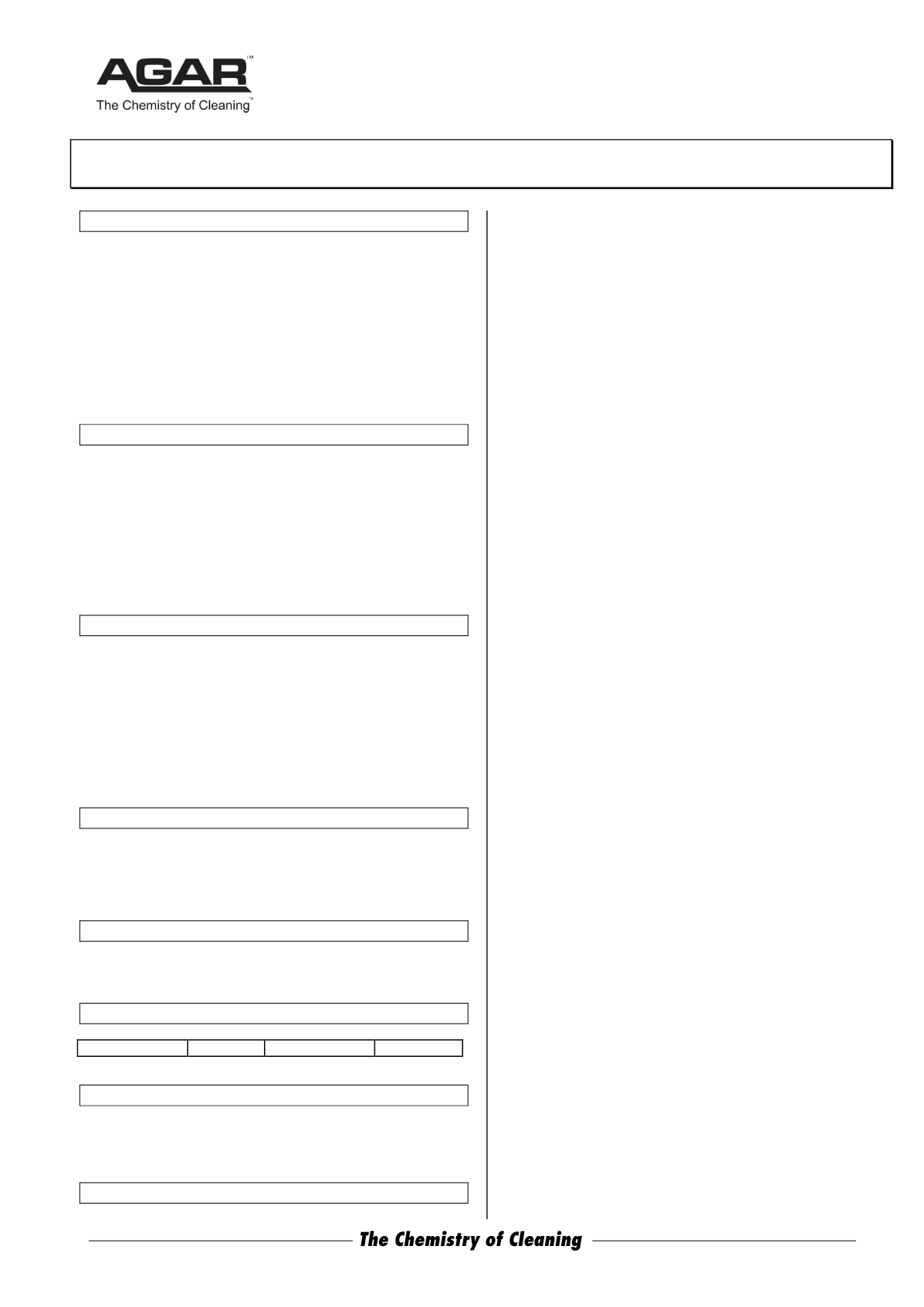

ABN 80 004 726 890 | MADE IN AUSTRALIA
Safety Data Sheet
Issued: August 30, 2013
Page 2 of 2
CONCRETE REMOVER CR-50
9 PHYSICAL AND CHEMICAL PROPERTIES
Appearance: Clear, green liquid.
Odour: None
pH = 1.7 ± 0.5
Vapour Pressure: N/K
Vapour Density: N/K
Boiling Point: N/K
Freezing Point: < 0
°
C
Solubility in water: Infinitely miscible
Specific Gravity: 1.0 – 1.1 (20
°
C)
Evaporation rate: As water
% Volatile by vol: > 50%
10 STABILITY AND REACTIVITY
Concrete Remover CR-50 is stable.
Concrete Remover CR-50 and its solutions may etch and
damage aluminium, zinc, diecast and other soft metal alloys as
well as terrazzo, limestone and marble. Concrete Remover CR-
50 should not be allowed to come into contact with these
materials.
Hazardous polymerization: Will not occur.
11 TOXICOLOGICAL INFORMATION
Health Effects:
Acute -
Swallowed: Irritating – causes irritation to the mouth,
oesophagus and stomach.
Eye: Moderately irritating – causes stinging.
Skin: Moderately irritating. Irritant to the skin.
Inhaled: Moderately irritating.
Health Effects -
Chronic
: No data available.
12 ECOLOGICAL INFORMATION
Ecotoxicity: No data available.
Persistence and degradability: Biodegradable.
Mobility: -
Advice: Prevent entry to natural waterways.
13 DISPOSAL CONSIDERATIONS
For disposal, refer to State Land Waste Management Authority.
14 TRANSPORT INFORMATION
UN No.: -
Class: -
Packg.Group: - Hazchem: -
15 REGULATORY INFORMATION
Poisons Schedule Number: Schedule 5
16 OTHER INFORMATION
AICS Listing:
All components of Concrete Remover CR-50 are
listed on the Australian Inventory of Chemical Substances
(AICS).
Date: This SDS issued on August 30, 2013 shall remain valid
for 5 years unless a new SDS is issued in the meantime.
Please contact Agar Cleaning Systems P/L to ensure you have
the latest version of this product’s SDS.
Abbreviations and Definitions of terms used:
<
less than
>
greater than
AICS
Australian Inventory of Chemical
Substances
CAS
Chemical Abstracts Service (Registry
Number)
COD Chemical Oxygen Demand
deg C Degrees Celsius
g
gram
g/L grams per litre
HSIS
Hazardous Substance Information System
kg
kilogram
L
Litre
LC50
The concentration of a material (inhaled)
that will be lethal to 50% of the test animals.
LD50
The dose (swallowed all at once) which is
lethal to 50% of a group of test animals.
m3
Cubic metre or cu.m.
mg
milligram
mg/m3 milligrams per cubic metre
miscible A liquid that mixes homogeneously with
another liquid
N/A
Not applicable
N/K
Not known
NIOSH
National Institute for Occupational Safety
and Health
non-haz Non- hazardous
PEL
Permissible Exposure Limit
ppb
Parts per billion
PPE
Personal Protective Equipment
ppm Parts per million
‘Skin’
Ingredient may be absorbed through the skin
STEL Short term exposure limit: the average
airborne concentration over a 15 minute
period which should not be exceeded at
any time during a normal eight hour
workday.
TLV
Threshold Limit Value
TWA
Time Weighted average: the average
airborne concentration of a particular
substance when calculated over a normal
eight hour working day, for a five day week.
UN
United Nations (Number)
wt
Weight
The information in this Data Sheet is based on our present
knowledge. However, this shall not constitute a guarantee for
any specific product features and shall not establish a legally
valid contractual relationship. Agar Cleaning Systems accepts
no tortious or contractual liability for any loss or damages
suffered as a consequence of reliance on the information and
advice contained herein.
End of SDS.


















